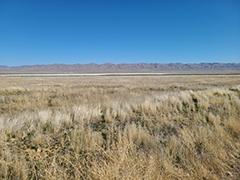Wildflower season is here – Do you know where to go?
Organization:
BLM Office:
Media Contact:
BAKERSFIELD, Calif. — The Bureau of Land Management advises wildflower enthusiasts to Know Before You Go and plan ahead as they make plans for wildflower viewing. As the Golden State’s rainfall is at near historic lows, blooms may not be bountiful, so assessing the situation before heading out is even more crucial this year.
Wildflowers typically bloom in the southern portion of the state first, and blooms then move north as the weather warms. According to the National Weather Service, some areas in central and southern California have received less than 20 percent of their normal precipitation this year. As a result, wildflower watchers may have better luck at less traditional viewing spots such as the Red Hills or the Merced River recreation management areas in Tuolumne County or Mariposa County, respectively.
The BLM is kicking off this year’s #TracktheBloom social media campaign to give wildflower watchers a realistic, on-the-ground look at current conditions at BLM-managed recreation sites throughout California. The public will be able to follow the #TracktheBloom on BLM California’s Facebook and Twitter accounts to view wildflowers virtually or find the best observation spots throughout the season.
One of the sites featured for #TracktheBloom will be the Carrizo Plain National Monument, a popular, but remote, wildflower location in San Luis Obispo County. Peak wildflower season for the monument is usually in late March to early April, but this year the area is experiencing dry conditions leading to a landscape covered in brown grasses and extremely sparse blooms.
Know Before You Go:
The Carrizo Plain National Monument offers visitors a rare opportunity to be alone with nature, but visitors need to be prepared. The monument does not have services such as water, food or fuel. Most monument roads are dirt and are impassible in wet weather. Vehicles must be street legal and stay on designated roads. Recreationists are encouraged to ensure their vehicle is in good working order, as roadside assistance is extremely limited. Cell phone coverage is spotty. The Goodwin Education Center is temporarily closed to help limit the spread of COVID-19.
Recreate Responsibly:
BLM-managed public lands are seeing a dramatic increase in the number of daily visitors since the closure of other recreation areas. Campgrounds are filled to capacity. The BLM encourages the public to recreate responsibly and to take precautions to reduce the risk of exposure to COVID-19. Stay local; plan ahead; do not gather in large groups; practice safe social distancing; take your own toilet paper, soap and hand sanitizer; pack out your trash and wear a mask when social distancing is not possible. Find additional tips for recreating responsibly on public lands at https://go.usa.gov/xs7DF.
Parking is limited and first-come, first-served at BLM day-use areas. Parking lots are often full by 7 a.m. on weekends and parking in “no parking” areas, on private land or blocking the roadway is not allowed. The BLM encourages visitors to have an alternate recreation area in mind if parking is full at their preferred location.
For more information on the Carrizo Plain National Monument please call the recorded information line at 805-475-2035 or visit www.blm.gov/visit/carrizo-plain-national-monument. For wildflower information, please follow #TracktheBloom on BLM California’s Twitter, Facebook and Flickr @BLMCA and @BLMCalifornia.
The BLM manages about 245 million acres of public land located primarily in 12 western states, including Alaska, on behalf of the American people. The BLM also administers 700 million acres of sub-surface mineral estate throughout the nation. Our mission is to sustain the health, diversity, and productivity of America’s public lands for the use and enjoyment of present and future generations.

